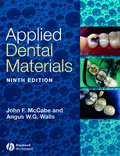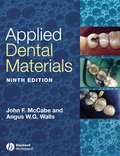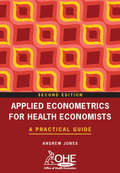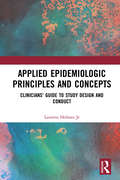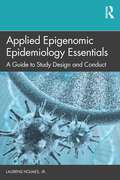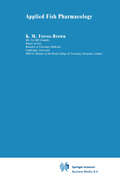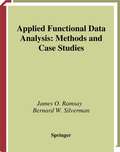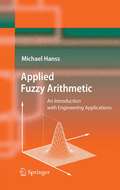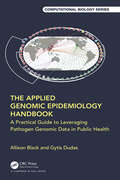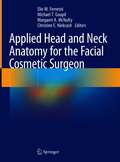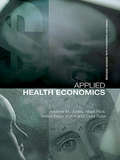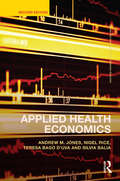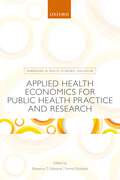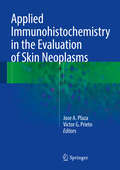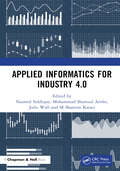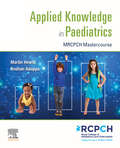- Table View
- List View
Applied Dental Materials
by John F. McCabe Angus W.G. WallsThis textbook covers all aspects of materials science relevant to the practice of dentistry. It is aimed primarily at undergraduate dental students, although it will also be useful for practising dentists, dental technicians and dental assistants. The 9th edition has been extensively revised to include the many advances in dental materials and their use that have occurred during the past nine years. The chapters on Resin-based filling materials and Adhesive restorative materials have been expanded significantly with new coverage of fibre reinforcement of composite structures and polymerisable luting agents. A brand new chapter has been added on endodontic materials.
Applied Dental Materials
by John F. McCabe Angus WallsThis textbook covers all aspects of materials science relevant to the practice of dentistry. It is aimed primarily at undergraduate dental students, although it will also be useful for practising dentists, dental technicians and dental assistants. The 9th edition has been extensively revised to include the many advances in dental materials and their use that have occurred during the past nine years. The chapters on Resin-based filling materials and Adhesive restorative materials have been expanded significantly with new coverage of fibre reinforcement of composite structures and polymerisable luting agents. A brand new chapter has been added on endodontic materials.
Applied Econometrics for Health Economists: A Practical Guide
by Andrew Jones"Applied Econometrics for Health Economists" introduces readers to the appropriate econometric techniques for use with different forms of survey data, known collectively as microeconometrics. The book provides a complete illustration of the steps involved in doing microeconometric research. The only study to deal with practical analysis of qualitat
Applied Epidemiologic Principles and Concepts: Clinicians' Guide to Study Design and Conduct
by Laurens Holmes, Jr.This book provides practical knowledge to clinicians and biomedical researchers using biological and biochemical specimen/samples in order to understand health and disease processes at cellular, clinical, and population levels. Concepts and techniques provided will help researchers design and conduct studies, then translate data from bench to clinics in attempt to improve the health of patients and populations. This book presents the extreme complexity of epidemiologic research in a concise manner that will address the issue of confounders, thus allowing for more valid inferences and yielding results that are more reliable and accurate.
Applied Epidemiologic Principles and Concepts: Clinicians' Guide to Study Design and Conduct
by Laurens Holmes, Jr.This book provides practical knowledge to clinicians and biomedical researchers using biological and biochemical specimen/samples in order to understand health and disease processes at cellular, clinical, and population levels. Concepts and techniques provided will help researchers design and conduct studies, then translate data from bench to clinics in attempt to improve the health of patients and populations. This book presents the extreme complexity of epidemiologic research in a concise manner that will address the issue of confounders, thus allowing for more valid inferences and yielding results that are more reliable and accurate.
Applied Epigenomic Epidemiology Essentials: A Guide to Study Design and Conduct
by Laurens Holmes, Jr.This applied clinical medicine and public health text introduces the fundamental concepts in epidemiological investigation and demonstrates how to integrate emerging research on epigenomics into practice. Epidemiology has a vital strategic role in facilitating and leading evidence discovery in all aspects of human health, with the intent of improving patient and public health through disease control and health promotion practices. It emphasizes what we now know about the transformation the human body and the ecosystem undergo as a result of social structure, environment, daily challenges and mutation. The first part of this text explores the origin of epidemiology, its relationship with medicine and public health, and its role in assessing disease distribution as occurrence or frequency, risk factors, treatment and management. The main direction of this text is to explore the assessment of how gene and environment interactions, termed epigenomic modulations, aberrantly predispose to morbidity, prognosis, survival and mortality at the individual as well as the specific population level. This text presents a novel approach based mainly on epigenomic modulations in the application of epidemiologic investigation in disease incidence, morbidity and mortality at a specific population level for graduate education in public health and clinical sciences as well as medical education.
Applied Epigenomic Epidemiology Essentials: A Guide to Study Design and Conduct
by Laurens Holmes, Jr.This applied clinical medicine and public health text introduces the fundamental concepts in epidemiological investigation and demonstrates how to integrate emerging research on epigenomics into practice. Epidemiology has a vital strategic role in facilitating and leading evidence discovery in all aspects of human health, with the intent of improving patient and public health through disease control and health promotion practices. It emphasizes what we now know about the transformation the human body and the ecosystem undergo as a result of social structure, environment, daily challenges and mutation. The first part of this text explores the origin of epidemiology, its relationship with medicine and public health, and its role in assessing disease distribution as occurrence or frequency, risk factors, treatment and management. The main direction of this text is to explore the assessment of how gene and environment interactions, termed epigenomic modulations, aberrantly predispose to morbidity, prognosis, survival and mortality at the individual as well as the specific population level. This text presents a novel approach based mainly on epigenomic modulations in the application of epidemiologic investigation in disease incidence, morbidity and mortality at a specific population level for graduate education in public health and clinical sciences as well as medical education.
Applied Fish Pharmacology (Aquaculture Series #3)
by K.M. Treves-BrownAs aquaculture continues to expand there is a need for greater knowledge of medicinal treatments both for the prevention and treatment of disease and for the economic husbandry of fish. This book, the first of its kind, is written for a worldwide readership. It is a reference manual for anyone involved in the selection of medicines for administration to fish. It will also be useful to administrators concerned with the legal control of aquaculture. The first part covers issues which affect all medicine's methods of administering drugs to fish, the various aspects of safety and the relevant legislation in countries with important aquacultural industries. Subsequent parts review the range of available medicinal substances and present current knowledge of the pharmacology and methods of use for each. Particular attention is given to safety issues - for the fish, for the person administering the medicine, for the consumer of medicated fish and for the environment.
Applied Functional Data Analysis: Methods and Case Studies (Springer Series in Statistics)
by J.O. Ramsay B.W. SilvermanThis book contains the ideas of functional data analysis by a number of case studies. The case studies are accessible to research workers in a wide range of disciplines. Every reader should gain not only a specific understanding of the methods of functional data analysis, but more importantly a general insight into the underlying patterns of thought. There is an associated web site with MATLABr and S?PLUSr implementations of the methods discussed.
Applied Fuzzy Arithmetic: An Introduction with Engineering Applications
by Michael HanssFirst book that provides both theory and real world applications of fuzzy arithmetic in a comprehensive style. Provides a well-structured compendium that offers both a deeper knowledge about the theory of fuzzy arithmetic and an extensive view on its applications in the engineering sciences making it useful for graduate courses, researchers and engineers. Presents the basic definitions and fundamental principles of fuzzy arithmetic, derived from fuzzy set theory. Summarizes the state-of-the-art stage of fuzzy arithmetic, offers a comprehensive composition of different approaches including their benefits and drawbacks, and finally, and presents a completely new methodology of implementation of fuzzy arithmetic with particular emphasis on its subsequent application to real-world systems. Concentrates on the application of fuzzy arithmetic to the simulation, analysis and identification of systems with uncertain model parameters, as they appear in various disciplines of engineering science. Focuses on mechanical engineering, geotechnical engineering, biomedical engineering, and control engineering.
The Applied Genomic Epidemiology Handbook: A Practical Guide to Leveraging Pathogen Genomic Data in Public Health (Chapman & Hall/CRC Computational Biology Series)
by Allison Black Gytis DudasThe Applied Genomic Epidemiology Handbook: A Practical Guide to Leveraging Pathogen Genomic Data in Public Health provides rationale, theory, and implementation guidance to help public health practitioners incorporate pathogen genomic data analysis into their investigations. During the SARS-CoV-2 pandemic, viral whole genome sequences were generated, analyzed, and shared at an unprecedented scale. This wealth of data posed both tremendous opportunities and challenges; the data could be used to support varied parts of the public health response but could be hard for much of the public health workforce to analyze and interpret, given a historical lack of experience working with pathogen genomic data.This book addresses that gap. Structured into eight wide-ranging chapters, this book describes how the overlapping timescales of pathogen evolution and infection transmission enable exploration of epidemiologic dynamics from pathogen sequence data. Different approaches to sampling and genomic data inclusion are presented for different types of epidemiologic investigations. To support epidemiologists in diving into pathogen genomic data analysis, this book also introduces the analytic tools and approaches that are readily used in public health departments and presents case studies to show step-by-step how genomic data are used and evaluated in disease investigations.Despite the breadth of scientific literature that uses pathogen genomic data to investigate disease dynamics, there remains little practical guidance to help applied epidemiologists build their ability to explore epidemiologic questions with pathogen genomic data. This handbook was written to serve as that guide. Including case studies, common methods, and software tools, this book will be of great interest to public health microbiologists or lab directors, bioinformaticians, epidemiologists, health officers, academics, as well as students working in a public health context.
The Applied Genomic Epidemiology Handbook: A Practical Guide to Leveraging Pathogen Genomic Data in Public Health (Chapman & Hall/CRC Computational Biology Series)
by Allison Black Gytis DudasThe Applied Genomic Epidemiology Handbook: A Practical Guide to Leveraging Pathogen Genomic Data in Public Health provides rationale, theory, and implementation guidance to help public health practitioners incorporate pathogen genomic data analysis into their investigations. During the SARS-CoV-2 pandemic, viral whole genome sequences were generated, analyzed, and shared at an unprecedented scale. This wealth of data posed both tremendous opportunities and challenges; the data could be used to support varied parts of the public health response but could be hard for much of the public health workforce to analyze and interpret, given a historical lack of experience working with pathogen genomic data.This book addresses that gap. Structured into eight wide-ranging chapters, this book describes how the overlapping timescales of pathogen evolution and infection transmission enable exploration of epidemiologic dynamics from pathogen sequence data. Different approaches to sampling and genomic data inclusion are presented for different types of epidemiologic investigations. To support epidemiologists in diving into pathogen genomic data analysis, this book also introduces the analytic tools and approaches that are readily used in public health departments and presents case studies to show step-by-step how genomic data are used and evaluated in disease investigations.Despite the breadth of scientific literature that uses pathogen genomic data to investigate disease dynamics, there remains little practical guidance to help applied epidemiologists build their ability to explore epidemiologic questions with pathogen genomic data. This handbook was written to serve as that guide. Including case studies, common methods, and software tools, this book will be of great interest to public health microbiologists or lab directors, bioinformaticians, epidemiologists, health officers, academics, as well as students working in a public health context.
Applied Head and Neck Anatomy for the Facial Cosmetic Surgeon
by Elie M. Ferneini Michael T. Goupil Margaret A. McNulty Christine E. NiekrashThis multi-authored, multi-institutional, and multi-specialty based text is designed to inform and refresh practitioners who perform facial cosmetic surgery. Divided into three distinct sections for ease of use, the first section focuses exclusively on localized anesthesia for each region of the head and neck. Chapters focus on the techniques that best affect these regions with a chapter closing the first section, on managing potential anesthetic complications. The second section covers the regional anatomy of the face by offering high definition photos of cadaver dissections and anatomic illustrations to highlight pertinent muscle and bone structures. The third and final section combines the skills detailed in the first two sections and applies them to a variety of surgical, cosmetic procedures. In an era of high demand for aesthetic procedures, this text provides a practical and comprehensive look at facial cosmetic surgery to ensure practitioners have the best information available for treating their patients. The editors have extensive academic experience and have authored multiple scientific publications, while the contributions included in the text have been written by experts and leaders in the field. Applied Head and Neck Anatomy for the Facial Cosmetic Surgeon is written for a multi-disciplinary audience including oral & maxillofacial surgeons, plastic surgeons, otolaryngologists, cosmetic surgeons, and dentists.
Applied Health Economics
by Andrew M. Jones Nigel Rice Teresa Bago D'Uva Silvia BaliaLarge-scale survey datasets, in particular complex survey designs such as panel data, provide a rich source of information for health economists. They offer the scope to control for individual heterogeneity and to model the dynamics of individual behaviour. However the measures of outcome used in health economics are often qualitative or categorical. These create special problems for estimating econometric models. The dramatic growth in computing power over recent years has been accompanied by the development of methods that help to solve these problems. This book provides a practical guide to the skills required to put these techniques into practice. This book illustrates practical applications of these methods using data on health from, among others, the British Health and Lifestyle Survey (HALS), the British Household Panel Survey (BHPS), the European Community Household Panel (ECHP) and the WHO Multi-Country Survey (WHO-MCS). Assuming a familiarity with the basic syntax and structure of Stata, this book presents and explains the statistical output using empirical case studies rather than general theory. Never before has a health economics text brought theory and practice together and this book will be of great benefit to applied economists, as well as advanced undergraduate and post graduate students in health economics and applied econometrics.
Applied Health Economics
by Andrew M. Jones Nigel Rice Teresa Bago D'Uva Silvia BaliaThe first edition of Applied Health Economics did an expert job of showing how the availability of large scale data sets and the rapid advancement of advanced econometric techniques can help health economists and health professionals make sense of information better than ever before. This second edition has been revised and updated throughout and includes a new chapter on the description and modelling of individual health care costs, thus broadening the book’s readership to those working on risk adjustment and health technology appraisal. The text also fully reflects the very latest advances in the health economics field and the key journal literature. Large-scale survey datasets, in particular complex survey designs such as panel data, provide a rich source of information for health economists. They offer the scope to control for individual heterogeneity and to model the dynamics of individual behaviour. However, the measures of outcome used in health economics are often qualitative or categorical. These create special problems for estimating econometric models. The dramatic growth in computing power over recent years has been accompanied by the development of methods that help to solve these problems. The purpose of this book is to provide a practical guide to the skills required to put these techniques into practice. Practical applications of the methods are illustrated using data on health from the British Health and Lifestyle Survey (HALS), the British Household Panel Survey (BHPS), the European Community Household Panel (ECHP), the US Medical Expenditure Panel Survey (MEPS) and Survey of Health, Ageing and Retirement in Europe (SHARE). There is a strong emphasis on applied work, illustrating the use of relevant computer software with code provided for Stata. Familiarity with the basic syntax and structure of Stata is assumed. The Stata code and extracts from the statistical output are embedded directly in the main text and explained at regular intervals. The book is built around empirical case studies, rather than general theory, and the emphasis is on learning by example. It presents a detailed dissection of methods and results of some recent research papers written by the authors and their colleagues. Relevant methods are presented alongside the Stata code that can be used to implement them and the empirical results are discussed at each stage. This text brings together the theory and application of health economics and econometrics, and will be a valuable reference for applied economists and students of health economics and applied econometrics.
Applied Health Economics
by Andrew M. Jones Nigel Rice Teresa Bago D'Uva Silvia BaliaThe first edition of Applied Health Economics did an expert job of showing how the availability of large scale data sets and the rapid advancement of advanced econometric techniques can help health economists and health professionals make sense of information better than ever before. This second edition has been revised and updated throughout and includes a new chapter on the description and modelling of individual health care costs, thus broadening the book’s readership to those working on risk adjustment and health technology appraisal. The text also fully reflects the very latest advances in the health economics field and the key journal literature. Large-scale survey datasets, in particular complex survey designs such as panel data, provide a rich source of information for health economists. They offer the scope to control for individual heterogeneity and to model the dynamics of individual behaviour. However, the measures of outcome used in health economics are often qualitative or categorical. These create special problems for estimating econometric models. The dramatic growth in computing power over recent years has been accompanied by the development of methods that help to solve these problems. The purpose of this book is to provide a practical guide to the skills required to put these techniques into practice. Practical applications of the methods are illustrated using data on health from the British Health and Lifestyle Survey (HALS), the British Household Panel Survey (BHPS), the European Community Household Panel (ECHP), the US Medical Expenditure Panel Survey (MEPS) and Survey of Health, Ageing and Retirement in Europe (SHARE). There is a strong emphasis on applied work, illustrating the use of relevant computer software with code provided for Stata. Familiarity with the basic syntax and structure of Stata is assumed. The Stata code and extracts from the statistical output are embedded directly in the main text and explained at regular intervals. The book is built around empirical case studies, rather than general theory, and the emphasis is on learning by example. It presents a detailed dissection of methods and results of some recent research papers written by the authors and their colleagues. Relevant methods are presented alongside the Stata code that can be used to implement them and the empirical results are discussed at each stage. This text brings together the theory and application of health economics and econometrics, and will be a valuable reference for applied economists and students of health economics and applied econometrics.
Applied Health Economics (Routledge Advanced Texts in Economics and Finance)
by Andrew M. Jones Nigel Rice Teresa Bago D'Uva Silvia BaliaLarge-scale survey datasets, in particular complex survey designs such as panel data, provide a rich source of information for health economists. They offer the scope to control for individual heterogeneity and to model the dynamics of individual behaviour. However the measures of outcome used in health economics are often qualitative or categorical. These create special problems for estimating econometric models. The dramatic growth in computing power over recent years has been accompanied by the development of methods that help to solve these problems. This book provides a practical guide to the skills required to put these techniques into practice. This book illustrates practical applications of these methods using data on health from, among others, the British Health and Lifestyle Survey (HALS), the British Household Panel Survey (BHPS), the European Community Household Panel (ECHP) and the WHO Multi-Country Survey (WHO-MCS). Assuming a familiarity with the basic syntax and structure of Stata, this book presents and explains the statistical output using empirical case studies rather than general theory. Never before has a health economics text brought theory and practice together and this book will be of great benefit to applied economists, as well as advanced undergraduate and post graduate students in health economics and applied econometrics.
Applied Health Economics for Public Health Practice and Research (Handbooks in Health Economic Evaluation)
by Rhiannon T. Edwards and Emma McIntoshIn today's world of scare resources, determining the optimal allocation of funds to preventive health care interventions (PHIs) is a challenge. The upfront investments needed must be viewed as long term projects, the benefits of which we will experience in the future. The long term positive change to PHIs from economic investment can be seen across multiple sectors such as health care, education, employment and beyond. Applied Health Economics for Public Health Practice and Research is the fifth in the series of Handbooks in Health Economic Evaluation. It presents new research on health economics methodology and application to the evaluation of public health interventions. Looking at traditional as well as novel methods of economic evaluation, the book covers the history of economics of public health and the economic rationale for government investment in prevention. In addition, it looks at principles of health economics, evidence synthesis, key methods of economic evaluation with accompanying case studies, and much more. Looking to the future, Applied Health Economics for Public Health Practice and Research presents priorities for research in the field of public health economics. It acknowledges the role played by natural environment in promoting better health, and the place of genetics, environment and socioeconomic status in determining population health. Ideal for health economists, public health researchers, local government workers, health care professionals, and those responsible for health policy development. Applied Health Economics for Public Health Practice and Research is an important contribution to the economic discussion of public health and resource allocation.
Applied Health Economics for Public Health Practice and Research (Handbooks in Health Economic Evaluation)
In today's world of scare resources, determining the optimal allocation of funds to preventive health care interventions (PHIs) is a challenge. The upfront investments needed must be viewed as long term projects, the benefits of which we will experience in the future. The long term positive change to PHIs from economic investment can be seen across multiple sectors such as health care, education, employment and beyond. Applied Health Economics for Public Health Practice and Research is the fifth in the series of Handbooks in Health Economic Evaluation. It presents new research on health economics methodology and application to the evaluation of public health interventions. Looking at traditional as well as novel methods of economic evaluation, the book covers the history of economics of public health and the economic rationale for government investment in prevention. In addition, it looks at principles of health economics, evidence synthesis, key methods of economic evaluation with accompanying case studies, and much more. Looking to the future, Applied Health Economics for Public Health Practice and Research presents priorities for research in the field of public health economics. It acknowledges the role played by natural environment in promoting better health, and the place of genetics, environment and socioeconomic status in determining population health. Ideal for health economists, public health researchers, local government workers, health care professionals, and those responsible for health policy development. Applied Health Economics for Public Health Practice and Research is an important contribution to the economic discussion of public health and resource allocation.
Applied Immunohistochemistry in the Evaluation of Skin Neoplasms
by Jose A. Plaza Victor G. PrietoThis book provides a comprehensive, state-of-the-art account of the role of immunohistochemistry in the diagnosis of skin tumors, which is crucial given that overlapping histologic features and unusual morphologic changes can lead to considerable diagnostic uncertainty. The book reviews in detail the sensitivity and specificity of commonly available antibodies and their pattern of immunostaining. readers will learn when to order antibodies and how to interpret findings. In addition, prognostic markers are evaluated and emphasis placed on the pitfalls commonly encountered when evaluating these neoplasms. The text is complemented by a wealth of superb images. Helpful histograms and algorithms are included, and clear guidance is provided on the application and interpretation of less commonly used antibodies and immunostains. Applied Immunohistochemistry in the Evaluation of Skin Neoplasms will serve as an extremely valuable resource for practicing dermatopathologists and pathologists.
Applied Informatics for Industry 4.0
by Nazmul Siddique Mohammad Shamsul Arefin Julie Wall M Shamim KaiserApplied Informatics for Industry 4.0 combines the technologies of computer science and information science to assist in the management and processing of data to provide different types of services. Due to the adaptation of 4.0 IR-related technologies, applied informatics is playing a vital role in different sectors such as healthcare, complex system design and privacy-related issues. This book focuses on cutting edge research from the fields of informatics and complex industrial systems, and will cover topics including health informatics, bioinformatics, brain informatics, genomics and proteomics, data and network security and more. The text will appeal to beginners and advanced researchers in the fields of computer science, information sciences, electrical and electronic engineering and robotics.
Applied Informatics for Industry 4.0
by Nazmul Siddique Mohammad Shamsul Arefin Julie Wall M. Shamim KaiserApplied Informatics for Industry 4.0 combines the technologies of computer science and information science to assist in the management and processing of data to provide different types of services. Due to the adaptation of 4.0 IR-related technologies, applied informatics is playing a vital role in different sectors such as healthcare, complex system design and privacy-related issues. This book focuses on cutting edge research from the fields of informatics and complex industrial systems, and will cover topics including health informatics, bioinformatics, brain informatics, genomics and proteomics, data and network security and more. The text will appeal to beginners and advanced researchers in the fields of computer science, information sciences, electrical and electronic engineering and robotics.
Applied Intelligence for Medical Image Analysis
by Mukesh Saraswat Himanshu Mittal Raju PalOver the last decades, there has been a revolution in the use of new intelligent technologies to analyze and interpret medical images for diseases diagnosis, assessment ad treatment. This new volume explores the latest cutting-edge research in medical image analysis. The advanced intelligent technologies discussed include machine learning, ensemble methods in machine learning, deep learning methods and firebase technology, infrared thermography, deep convolution neural networks, and more. Some of the specific uses of these technologies include for brain tumor MRIs, for breast cancer screening, for polycystic ovary syndrome classification, for detecting and monitoring Alzheimer’s disease, for monitoring of newborns, for retinal disease diagnosis, for Covid-19 detection, and more.
Applied Intelligence for Medical Image Analysis
Over the last decades, there has been a revolution in the use of new intelligent technologies to analyze and interpret medical images for diseases diagnosis, assessment ad treatment. This new volume explores the latest cutting-edge research in medical image analysis. The advanced intelligent technologies discussed include machine learning, ensemble methods in machine learning, deep learning methods and firebase technology, infrared thermography, deep convolution neural networks, and more. Some of the specific uses of these technologies include for brain tumor MRIs, for breast cancer screening, for polycystic ovary syndrome classification, for detecting and monitoring Alzheimer’s disease, for monitoring of newborns, for retinal disease diagnosis, for Covid-19 detection, and more.
Applied Knowledge in Paediatrics: : MRCPCH Mastercourse - E-Book
by Martin Hewitt Roshan AdappaThe essential guide to passing the MRCPCH Applied Knowledge in Practice (AKP) exam. Closely aligned to the Royal College of Paediatrics and Child Health (RCPCH) theory examination syllabus and also reflective of current UK practice. Applied Knowledge in Paediatrics will leave the reader with a sound knowledge of all the core topics relevant to paediatrics and child health. It will also provide a useful study aid for those undertaking the MRCPCH Applied Knowledge in Practice examination. The book covers how and why illnesses develop in children and young people, the appropriate investigations and treatment required, the urgency of implementation and the impact of the disease process on the child and their family. This comprehensive text is edited by Dr Martin Hewitt, a Senior Theory Examiner for the AKP examination, and Dr Roshan Adappa a Senior clinician and postgraduate trainer, with expert input from more than 60 paediatric specialists. 33 chapters provide comprehensive information of all areas of paediatric practice. Directly aligned to the Applied Knowledge in Practice syllabus and examination 50 sample questions along with answers and reasoning explaining each of the answer options Chapter on how to prepare for the RCPCH AKP examination Clinical scenarios in each chapter outlining difficult clinical problems and proposed management plans Clinical images to aid understanding Level of detail to support clinical practice of paediatricians with 12-18 months experience
